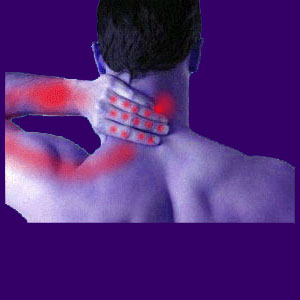
A numb arm is one of the sensory symptoms sometimes associated with pinched nerves and other upper back and neck pain syndromes. However, numbness can come about due to other sources, including non-spinal nerve compression, disease processes and even psychogenic explanations.
Numbness comes in 2 distinct varieties. The first is pure, objective numbness, which is rarely reported. The second and far more common symptomatic expression is subjective or partial numbness.
A numb feeling in the arm is most often experienced in conjunction with pain, weakness or pins and needles in the shoulder, neck, hand or fingers. In fact, it is extremely rare that numbness is the only reported patient complaint in the arms.
This essay examines many possible causes of numbness in the arms, with a primary focus on neurological mechanisms in the cervical spinal region.
Numb Arm Causes
Central spinal stenosis in the neck might be the reason for arm numbness in some patients. However, in these scenarios, symptoms are usually wide-ranging and will not consist exclusively of a lack of feeling in the arm or arms. When many symptomatic locations exist concurrently, the chances of central stenosis being to blame increase drastically, particularly in the elderly.
However, the most commonly implicated diagnosis used to explain numbness in the arm is complete foraminal stenosis, leading to a compressive neuropathy condition in the cervical or thoracic spinal zones.
The middle and lower cervical nerve roots, as well as the uppermost thoracic nerve roots play roles in innervating the arms. When these nerves are affected by verified compression, they may suffer dysfunction, leading to a full range of possible symptomologies, including arm numbness.
While it is possible for a true pinched nerve to create numbness, the eventual result is almost always the total objective variety of the symptom, which is not commonly reported by most patients.
Far more typical is subjective numbness accompanied by neck or upper back pain, tingling and possible weakness.
The logical explanation for this type of expression is usually mindbody ischemia, since this oxygen deprivation syndrome is very common and variable in its symptomology. Most cases of chronic ischemia are sourced by structural circulatory problems or are created purposefully by a mindbody disorder, such as tension myoneural syndrome.
In some instances, severe thoracic outlet syndrome might be involved in creating numbness in the shoulder or arm. However, once again, the condition is usually marked by multiple symptoms, including pain and weakness, instead of simple numbness. Many cases of thoracic outlet are originally misdiagnosed, while symptoms are often incorrectly linked to innocent spinal abnormalities in the cervical spine, such as intervertebral herniations.
Some diseases can cause numbness in certain anatomical locations. However, most of these possible explanations for arm numbness can be easily confirmed, or ruled out through the most basic diagnostic evaluations.
Numb Arm Cautions
Numbness in the arm, or anywhere in the upper body, can be the sign of a very serious health condition. Some of these significant health threats might include cancer or myocardial infarction. Always be sure to consult with your doctor to report any new or sudden-onset symptoms involving numbness.
Remember that every individual area of the arm is innervated by different nerve roots. Be sure that the areas of the arm that are affected by numbness correlate to the theorized-to-be-compressed root structures.
Be careful of subscribing to the spinal nerve compression theory when numbness is subjective. In some cases, this diagnosis turns out to be inaccurate, with a coincidental herniated disc or arthritic process taking blame for causing symptoms that are actually resulting from some other non-spinal or even nonstructural mechanism.
Be sure to seek expert correlation of any suspected spinal causation with a qualified neurologist for best diagnostic results.
Numb Arm Relief
Once the true underlying causation of arm numbness is identified, treatment can be enacted. The type of therapy used will depend wholly on the nature of the symptomology and might include pharmaceutical care, conservative ongoing care, surgical intervention or some other treatment modality.
Spinal sources of neurological compression will generally not resolve with nonsurgical care, but some may. This is particularly true for single nerve root compression conditions caused by bulging spinal discs. However, true permanent stenosis, that is caused by arthritic build-up, injury, developmental or congenital changes, will most often require surgical intervention to cure.
Mindbody varieties of simple numbness are rare, unless they also feature additional symptoms. However, when numbness exists with pain, tingling or weakness and no definitive structural explanation is found, knowledge therapy might provide lasting resolution by addressing the causative psychoemotional dynamics that are enacting the symptom set in the arm, or elsewhere.





